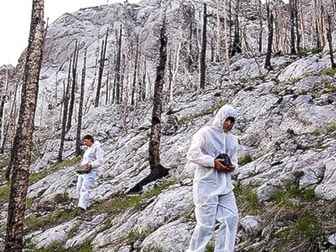Vernon Morning Star
Hazmat-suited humans climb up and down a gray and white chalky moonscape, their hands cupping angular chunks of rock.
It’s a strange image that warrants a second or third look, making the viewer wonder, “What are these people doing, and where is this place?”
That’s exactly the reaction artist Kristoff Steinruck says he wants when he shows his multi-media installation, which consists of photographs, hand-carved stone elements, and a single channel projection video. The installation opened last week at the Vernon Public Art Gallery.
Entitled The Marble Range, the landscape and limestone within the exhibition looks like it was taken from outer space, while the rock tells a history that extends back to 300 million years ago.
“I have a big interest in science fiction and the way time is portrayed in it,” said Steinruck, who is based in Kelowna. “Geological history is about deep time and is difficult to grasp: Think of stone formed by these little shells and then moving half way around the world, and then crumpled up into a massive jumble of rock. It’s that relationship with time and its relationship with the earth that I find fascinating.”
This all makes a bit more sense once you see, and experience, the actual Marble Range portrayed in Steinruck’s exhibition. Known for its unusual karst (limestone) topography, the Marble Range is actually a protected B.C. park located between Cache Creek and Pavilion.
“When I first saw the Marble Range, it became clear that I could work with this area. I like to work in a site-specific manner either in the landscape and/or with it,” said Steinruck, “The Marble Range is not a well-known place. The trails are not well marked. To get there you have to drive down a dirt road. There’s not much of a profile for tourism.”
Originally from Rossland, Steinruck worked in the dirt as a tree planter, and for a decade, between doing his bachelor of arts at UBC Vancouver and earning his master’s in fine art in Guelph, Ont., he was a photographer working for publications such as Maclean’s Magazine and The Globe and Mail.
It was while in Ontario that he became interested in more three-dimensional art forms and started sculpting. After moving to the Okanagan three years ago to be closer to family, he continued to work with the elements and in particular, rock.
He had worked with limestone, which resembles concrete offset with white chalky veins, in southern Ontario, and was purchasing the stone from a landscape supplier outside of Guelph. His quest to find limestone in B.C. resulted in little success at first.
“I wanted to continue working with limestone and called around. No one had any. After more research, and looking at geographical survey maps, I uncovered three places in B.C. with significant limestone deposits,” he said. The stone from a quarry on Texada Island, near Powell River, was too solid and gray, while another deposit in the Rockies was hard to access.
And then Steinruck hit the mother lode, paying his first visit to the Marble Range. “I saw the mountains, and how beautiful and strange they looked compared to the rest of the geology in B.C.,” he said, adding he “stole” a piece of the rock to take back to his studio in Kelowna.
He conducted research on the stone and its geological history, enlisting UBC geology professor Kyle Larson to help him. Larson was familiar with the stone, as he had done field studies at a nearby deposit in Cache Creek. At his Vancouver lab, Larson cut the rock thinly and shone a light through it to see the crystals, and get a better idea of the history within. It turns out the fossils consisted of tiny shells dating back 200 – 300 million years ago.
“The shells came from a tropical island somewhere in the Pacific and moved through tectonic plates to its present location in North America,” said Steinruck.
After carving the stone, Steinruck decided to bring the resulting sculptures, six in all, back to the range where they came from. He enlisted people, mostly performers, to carry each stone through the landscape, using his photographic and video skills to capture their rather arduous journey.
“Taking people up and down the steep side of a mountain with a heavy stone sculpture weighing 50 pounds was a bit risky, but I discovered they had the same sort of reaction I had when I first went there. Seeing the landscape, and touching it was an amazing, moving experience.”
Steinruck hopes viewers seeing the exhibition for the first time will have the same sort of reaction.
“I am trying to put life into the sculptures and provide a narrative,” he said. “It was important for me to translate this place and the material found in the world around us and translate it into an artistic form and imbue it with a sense of experience and life.”
The Marble Range can be viewed at the Vernon Public Art Gallery through to October. Call (250) 545-3173 for more information.
